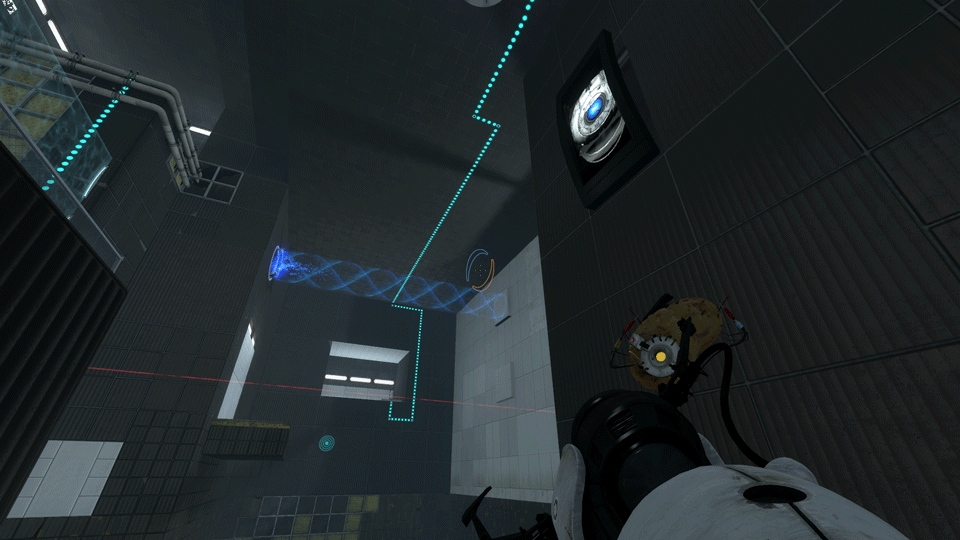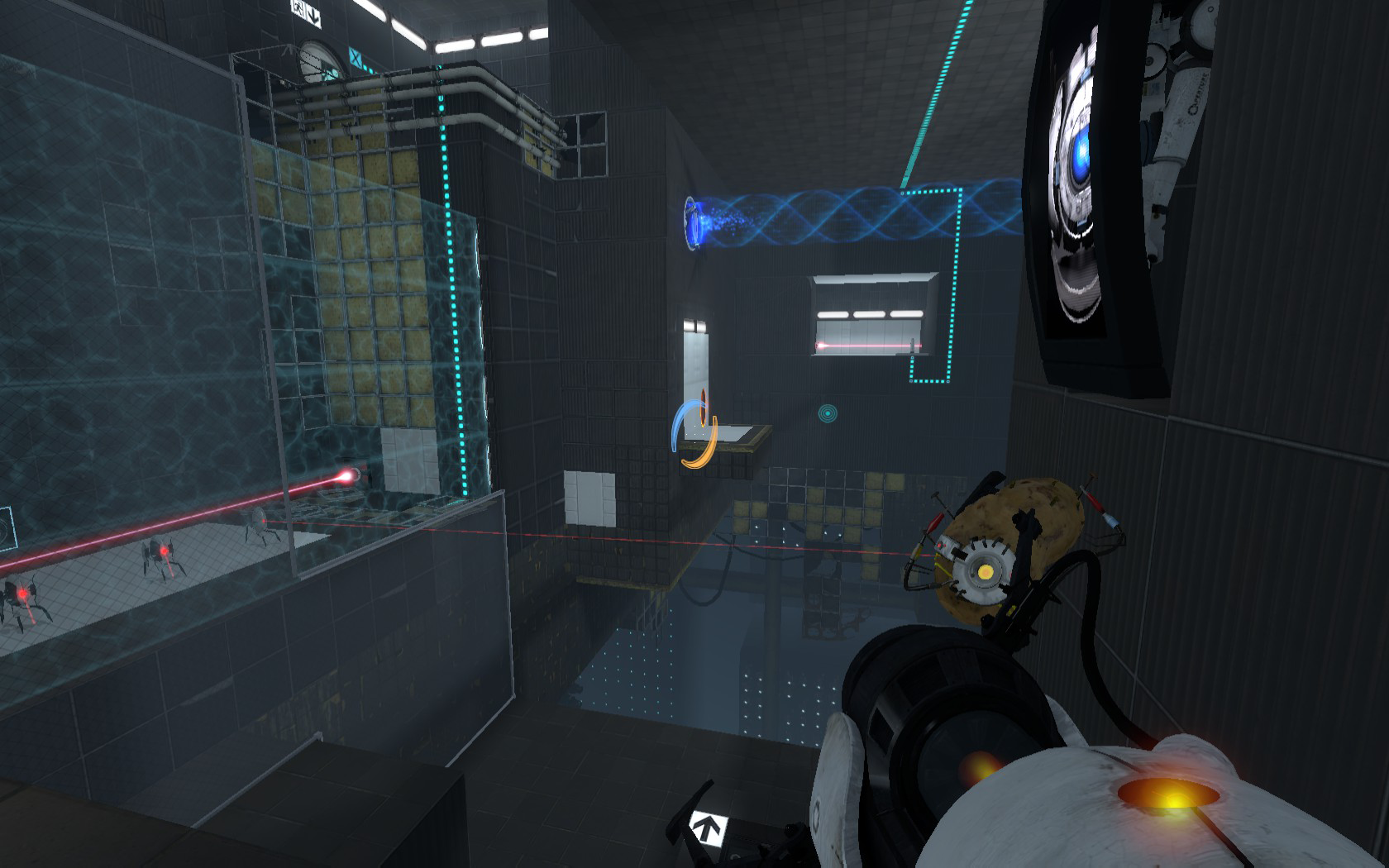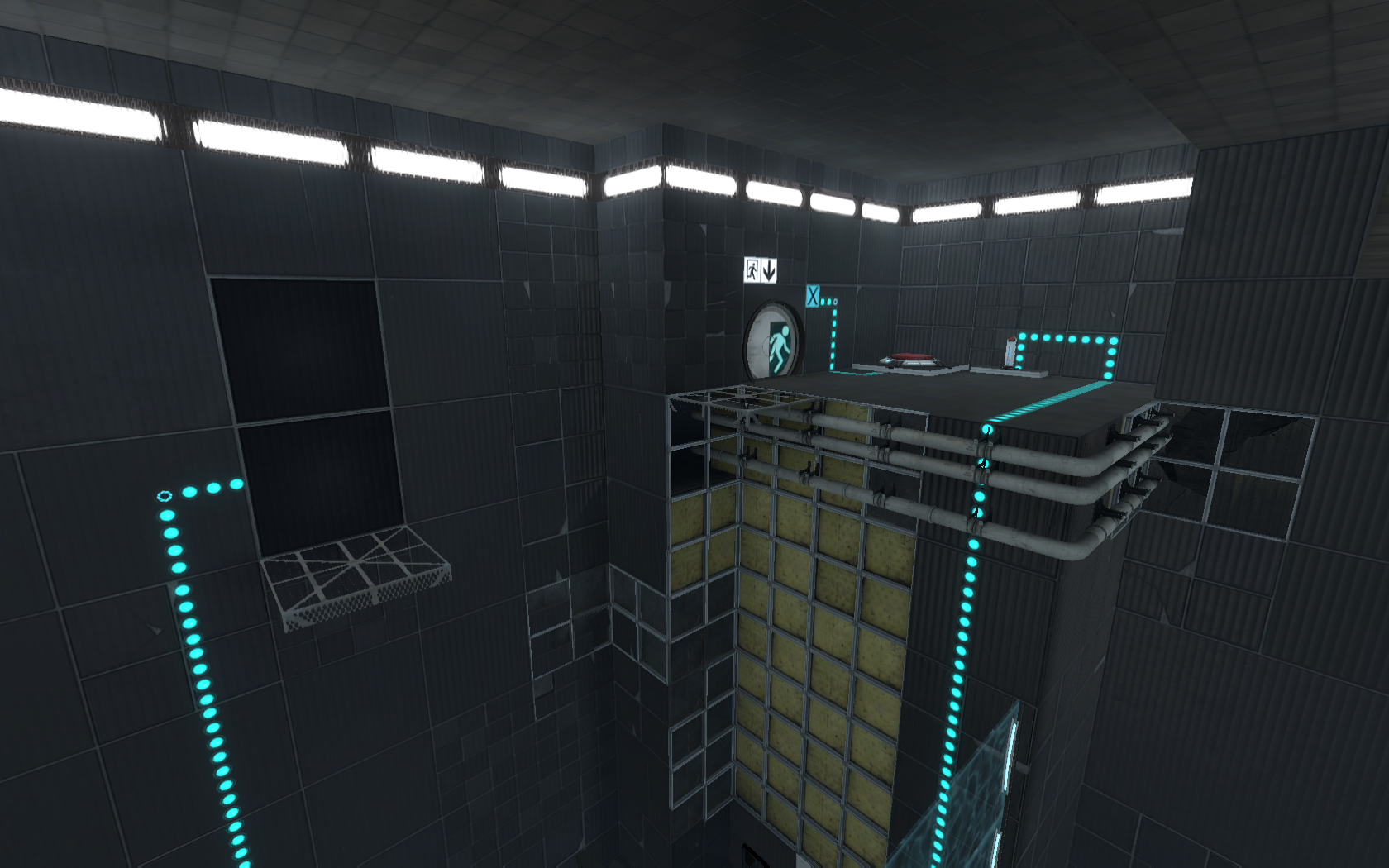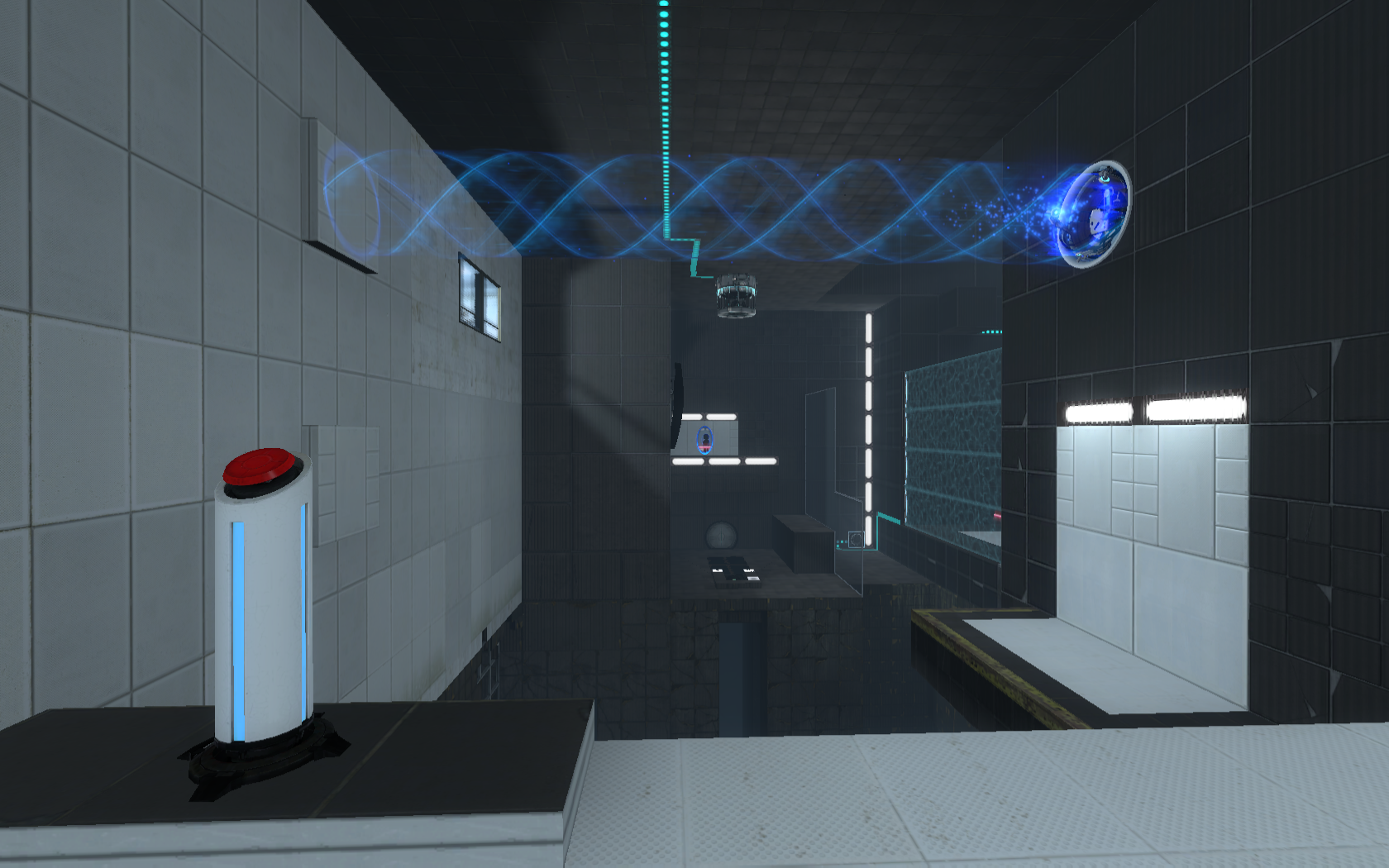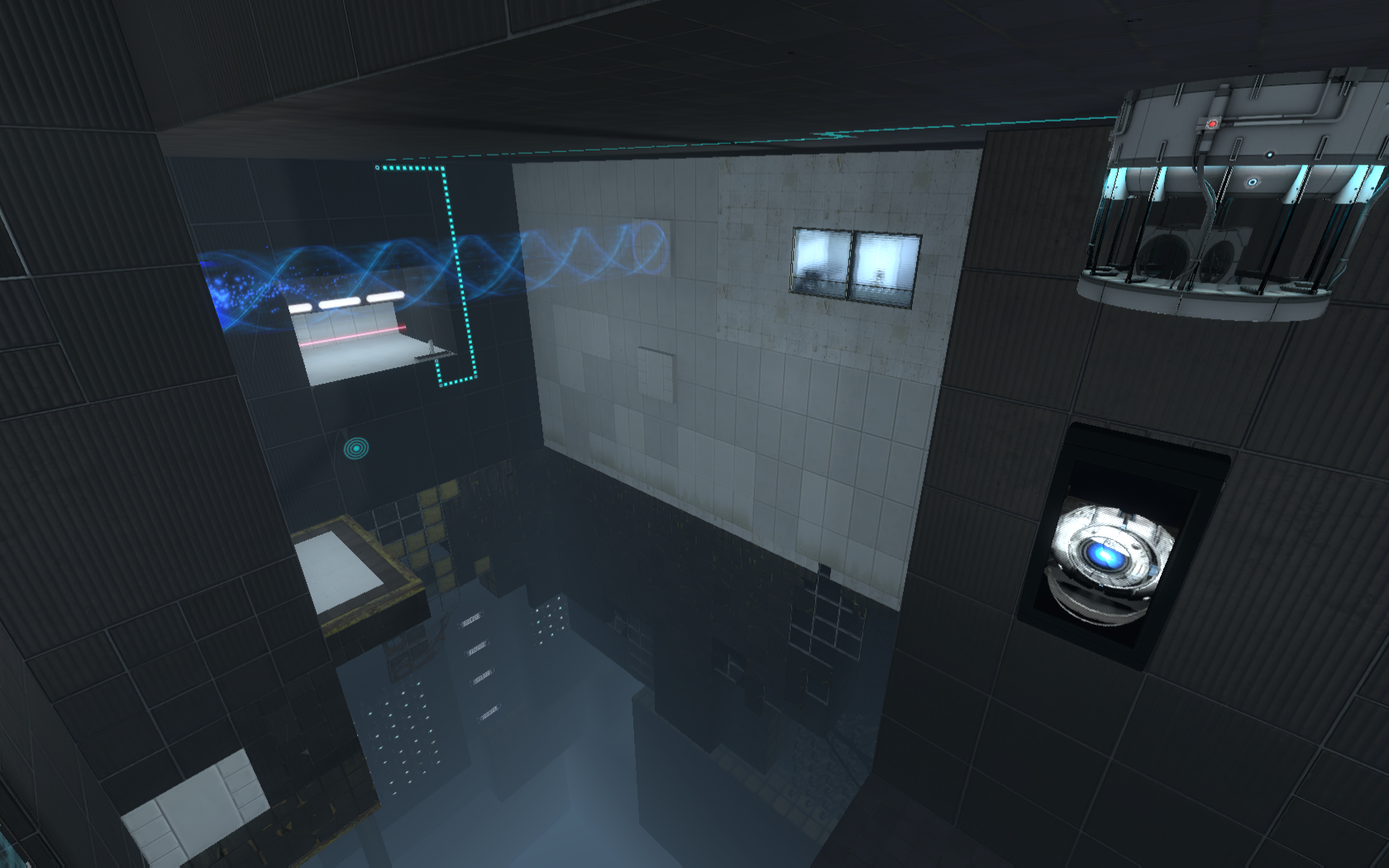Portal 2 The Itch: Omitted Chamber
Summary
The Itch: Omitted Chamber is a level for Portal 2, made in 2.5 weeks half-time. It is made to be a room that would fit into 'Chapter 8: The Itch' in Portal 2, using the same game mechanics, props and features.
Specifications
- Created in 2.5 weeks half-time
- Prototyped in Portal 2 Perpetual Testing Initiative
- Customized in Hammer
- Based on 'Chapter 8: The Itch' in Portal 2
My workflow
- Pre-production research of the original game
- Prototyping and playtesting in Perpetual Testing Initiative
- Choosing one prototype to modify in Hammer
- Set dressed the level in Hammer to fit in with Chapter 8
- Added special level features prominent in Chapter 8
- Wheatley monitor
- Explosion ambience surrounding the chamber
- Potato GLaDOS
- Polish & bugfixing
- Published on Steam Workshop
Pre-production
One lesson that I learned from making Secret of the Forest Temple was that a clear vision is extremely helpful when you want to make a lot of content quickly. This is why I put heavy emphasis on preproduction for this map.
I wanted to make something that could fit into the original Portal 2 so I started off my work with a thorough playthrough of the game. Chapter 8: The Itch, the segment where Wheatley takes over the factory, was the one I found the most interesting so I decided to base my level on it. As soon as I'd decided, I started specific research on that section, taking screenshots and listing gameplay mechanics commonly used.

To get started, I used a decompiling tool to bring the maps from the original Portal 2 game into Hammer. This way, I made a list of which textures and props were used and where, to use as a guide and make my level seem as authentic as possible.
I also took a thorough look at the size of the levels in this segment and found that the individual levels in Portal 2 were made up of many big rooms, but each room was self-sufficient as a puzzle chamber. I decided for my level to try and create one such room since it seemed like a good scope for my timeframe of 2.5 weeks half-time.

Prototyping in Perpetual Testing Initiative, PTI
When emerging from the preproduction phase, I knew that I wanted to make a level with lasers and funnels, maneuvering around a bottomless pit. Since PTI is a very easy tool to work with it was a quick, iterative process from here. After scrapping a couple of concepts and then iterating on the best one based on feedback, I got to a point where I felt that I could take the level into Hammer and start working on the environment. At this point, I had the level in pretty much the exact gameplay state as the finished product. When making my next Portal 2 level, I will make sure to spend a lot of time in this prototyping phase since it is so valuable to make quick iterations.
It was a great decision to let test subjects (friends and classmates) playtest each iteration of the level while in PTI, as it contributed to make the map interesting and playable quickly. For every new problem that someone would discover, there would be new ideas to solutions but also interesting discussions about possibilities to evolve the map.
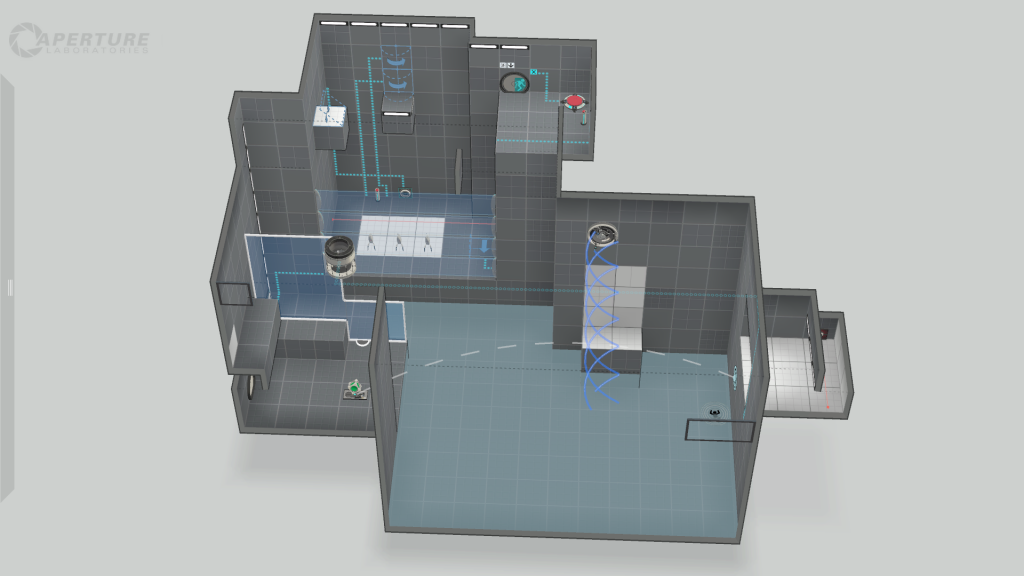
My finished puzzle maker prototype still provides a very accurate overview of the gameplay of my level.
Leading the player
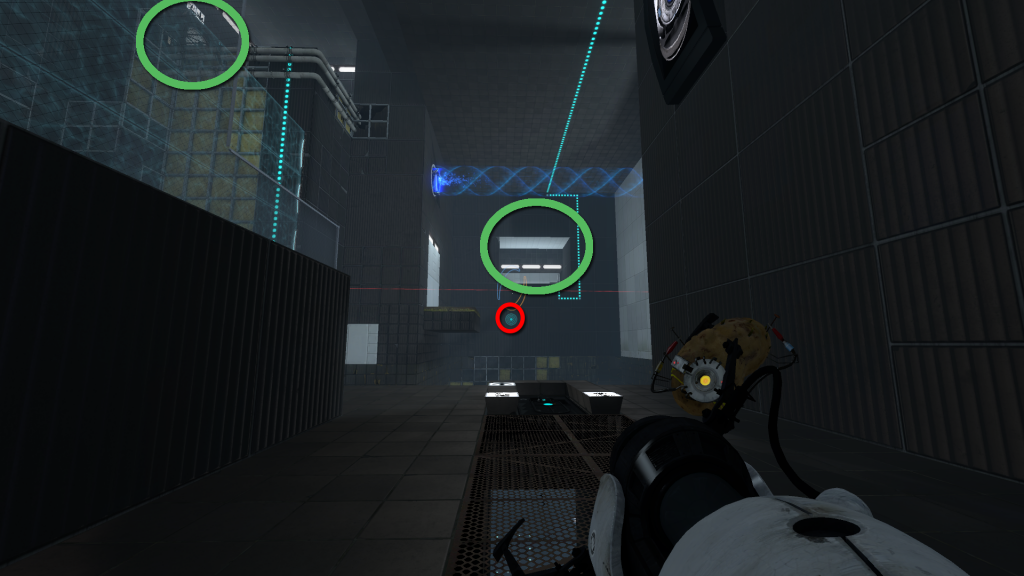
The very first view the player gets of the room shows some crucial elements to solving it.
The next step shows the player the solution to reaching the exit - turning off the fizzler with the help of a laser receiver (right circle). In this area, the player finds both the laser and the cube needed to redirect it into the receiver. The cube is dropped over the funnel and the player needs to guide it to the platform using the funnel just like before.
However, the area from where the laser can reach the receiver is hidden to the player from this viewpoint - the player needs to return to the other side of the gap (left circle) in order to guide the laser. Thankfully, it is just a normal portal away from the player now that they have portal surfaces around them, but I was surprised to see how many players had difficulty figuring out this step. To combat this, I made sure to put lights all around the portal where the player should go next.
When the player enters the chamber, they get a pretty clear look over the level and I wanted to draw attention to two areas. The portal surface straight ahead across the gap, the exit, which is lit up in the area to their top left. As the player progress into the room, the turrets to the left will draw their attention to the turrets and fizzler blocking the path to the exit. This sets the goal firmly in the player's mind.
If the player is experienced, they will also immediately spot the faith-plate marker which is straight ahead, and notice that they will fall to their death if they step on it without thinking. Since I want the map to fit into Chapter 8, this makes sense based on the supposed difficulty level my player is at.
The player can navigate across the map using the faith plate and the funnel, catching themselves with the funnel in mid-air. When they are across, they can use the portals along the wall to get to the area straight ahead.
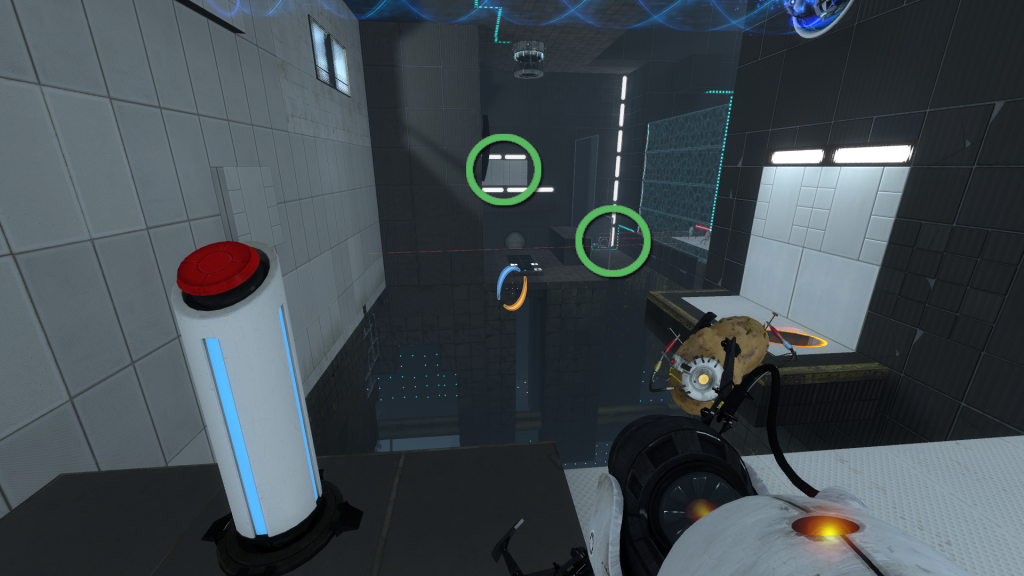
The areas the player needs to notice are lit up
When the player has finally redirected the laser correctly they can enter the turret area. If their aim is good, they are rewarded with this gameplay moment.
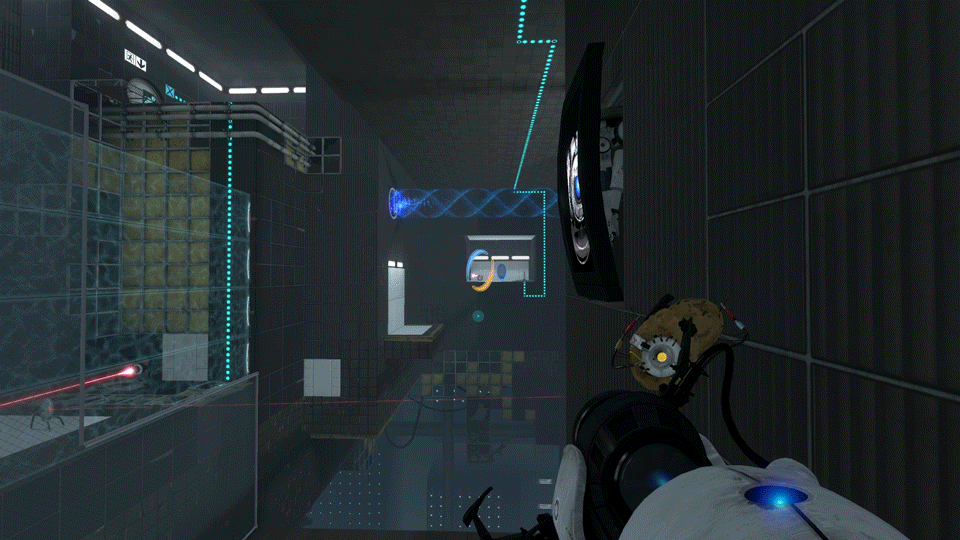
When the player diverts the laser into the room they are rewarded with this pretty satisfying triple kill.
Playful ending
As the player enters the area behind the fizzler, they can push a button to flip a panel on top of a high platform, making it easy for them to bypass the fizzler and go back and forth between the two areas of the map. When the player has reached this point of the map they need to also get the cube through in order redirect another laser, this time inside the fizzler area. This laser in turn enables another flip-switch that will allow the player to launch themselves to the exit from the high platform, using gravity and portals.
Once the player reaches the exit they find a button, and find they need to get the cube again! The players didn't want any more complexity this close to the finish line, so I made it easy but playful to bring the cube to the player. The player can push a button to flip a switch in the floor, and then use the funnel to raise the cube into the air from where you stand. When dropped into the flipped area from high above, it launches at high speed right into the waiting hands of the player as a fun and easy-going way to end the level. If the player chooses to jump down again the flipped area makes it very easy to get yourself and the cube back up using the funnel.
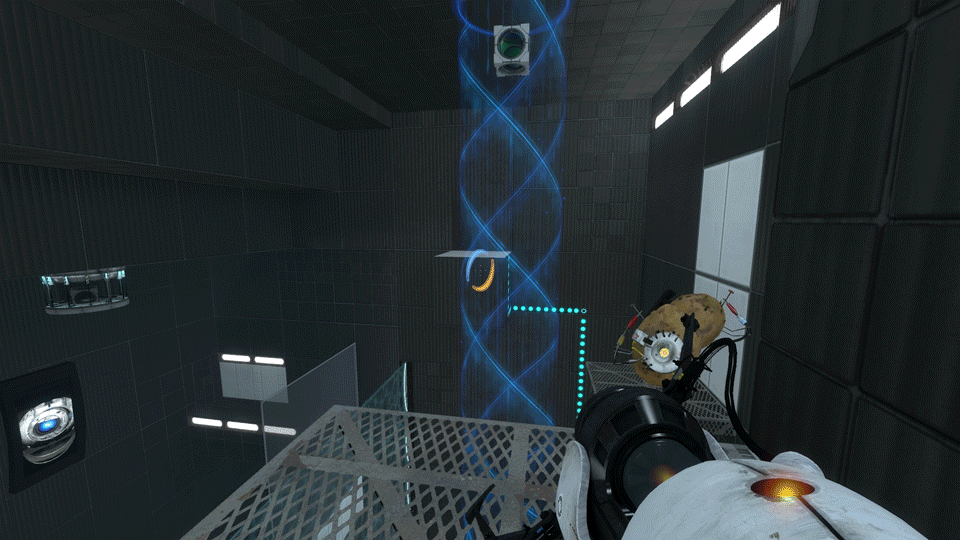
Minimal effort, maximum output!
Customization in Hammer
Bringing the level to Hammer was extremely important to sell the theme of my level. The most of my time was spent on decorating the level with the appropriate textures and props from 'Chapter 8: The Itch', as well as making the light tracks that lead to the different gameplay elements more clear in order to lead the player.
I was adamant to have a bottomless pit in my level, since they look so cool and are unique to the Wheatley setting. In the Portal 2 original game, they have devoted a lot of space to those areas that the player can look down on. Since one Portal 2 map holds multiple rooms. those large spaces can act as a backdrop for many different rooms. Since this was not the case for me, I could not make my bottomless pit in the same way that it was made in the original game. Instead, I made the area a lot smaller to make the compile time as short as possible, and repeatedly went into the game and looked from every angle to make sure that it compared to my reference setting.
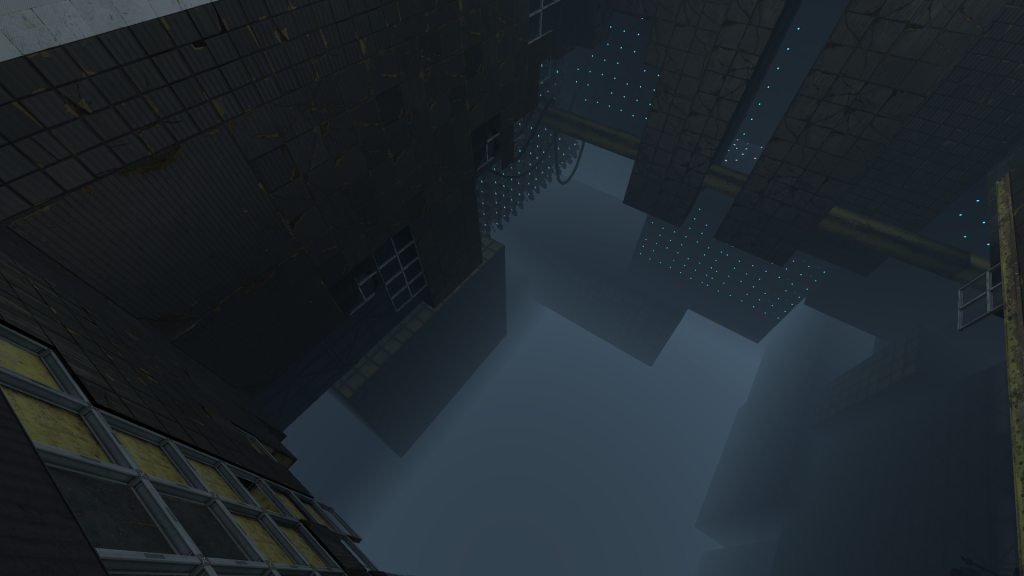
It was important to me that my bottom less pit felt mysterious and true to the original
To make the level feel authentic I also had to incorporate some of the key elements from Chapter 8. There are three things that in my opinion are essential to this theme; the Wheatley monitor, explosions surrounding the factory, and the potato GLaDOS on Chell's Portal Gun.
I used pre-made instances that I modified to fit my level in order to implement them. Especially the explosions that the player can feel shaking all around them contributes to the feeling of the factory crumbling around the player, an important feeling that is unique to Chapter 8.
Next step in the process to make this level as authentic as possible is to polish the entry and exit elevators, since they are the first and last impression of the level to the player. Most levels in this setting have the player taking unconventional routes to the elevators. While extremely cool it is also very time-consuming to build, so I chose to instead put more emphasis on the gameplay of my level during my timeframe.
I wanted my level to be a part of the story of Chell and potato GLaDOS being forced to test in a self-destructing factory, while being overseen by Wheatley.
Changes I would like to make
Some of the feedback I got gave me some great ideas for how to improve the map and create a better overview of the flow of the level. The main point of the feedback is that while the goal is always clear, the different stages to the map are a bit confusing. Sometimes the player loses track of where they are supposed to be - especially after entering the area behind the fizzler. Some of the changes that I would like to make are illustrated in the pictures below.
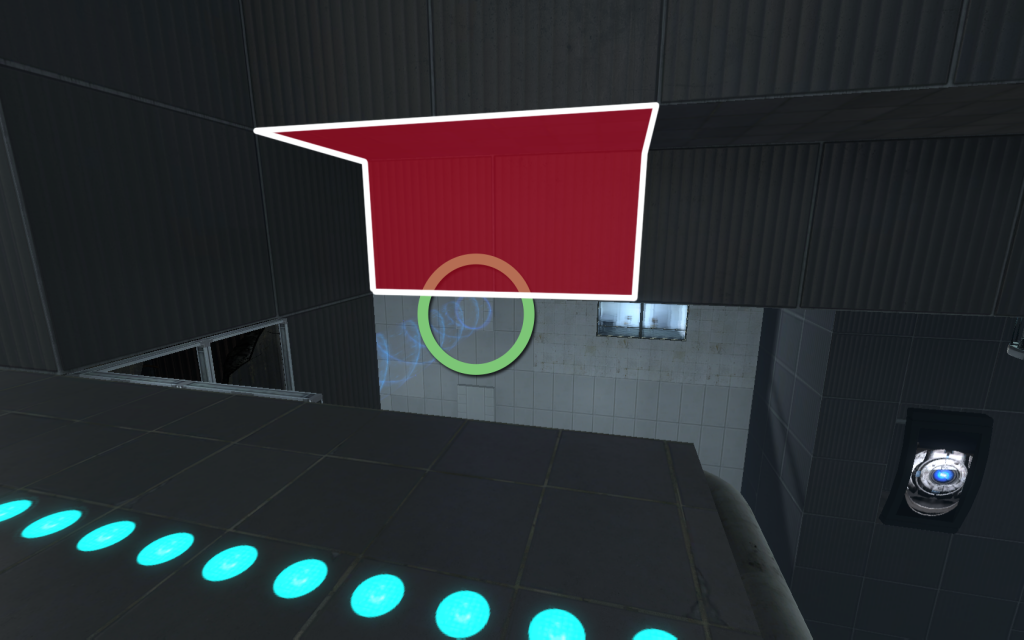
This area is the very end of the level, where the player is supposed to use the funnel one more time to bring the cube up to the button near the exit. I've seen players get confused at this point since they don't immediately notice that the funnel (green circle) is visible from this area. This is probably due to the ceiling in part obstructing the player's view.
The change I would make is to remove the red parts of the wall and ceiling and make an opening, framed with metal plates and broken pieces much like I've done with the broken floor. This hole would frame the funnel and make it more noticable to the player from this angle, preventing confusion and instead make the player feel smarter.
Creating the hole would also contribute to the feeling of the level being broken and the factory crumbling. It would be a good decision both from an immersion standpoint as well as gameplay-wise.
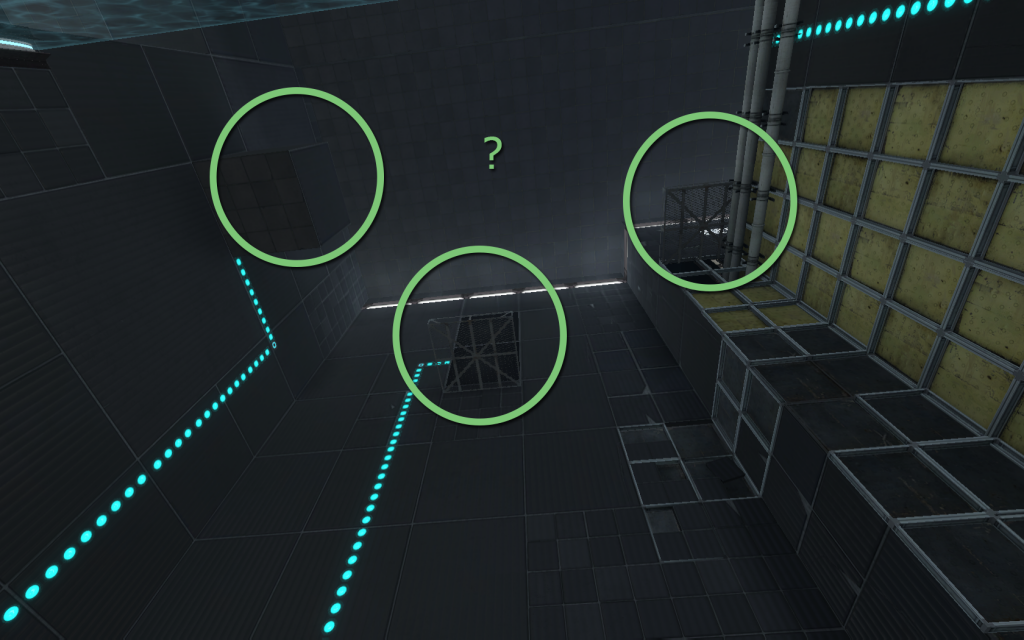 This point of view is also something that I would like to change since it is pretty confusing to the player, especially since they need to get up to the platform to fully see what is going on. The player can only go to them in a certain order but from this viewpoint they might not realise this and become uncertain, losing their flow.
This point of view is also something that I would like to change since it is pretty confusing to the player, especially since they need to get up to the platform to fully see what is going on. The player can only go to them in a certain order but from this viewpoint they might not realise this and become uncertain, losing their flow.
If given the time, my first-hand choice would be to rework the space to make the flow more clear. A simpler change would be to make the lighting more indicative. One idea I had in mind is to have a lamp that turns on over the leftmost platform as soon as you step onto the middle one, to create a sense of progression in the map.
Another idea is to create another hole in the roof over this area, with props like hanging cords pointing towards the platforms, making the space above them more eyecatching and drawing the players attention. In my opinion, you can't have too many broken walls and holes in this setting. 🙂
Exploits
I discovered while playtesting that there are certain exploits of the map that allows the player to skip certain elements. For the most part I absolutely love those kinds of exploits since they are new, exciting ways to solve the puzzle. From what I saw that the players love it as well, since it truly makes them feel like they outsmarted the map. For this setting I also feel that exploits are very appropriate since the level is supposed to be two different chambers pieced together by Wheatley.
There is one exploit in particular that allows the player to skip many elements in the map. Depending on how early it is discovered by the player, it can lead to different results. Sometimes it is just an additional element to solving the puzzle, other times the part behind the fizzler can be almost entirely skipped.
This does worry me since the level gets very short. The exploit certainly requires a lot of creative thinking and still requires the player to act in the level, and it is not a showstopper. However as currently is, the map gets too short to stand on its own with it in place. If the map was part of a chapter, it would have been another matter but for a level on the Steam Workshop, it doesn't work.
If I ever expanded on this map, I would feel very comfortable keeping the exploit as I think it adds a fun twist and serves as a reward to the player.
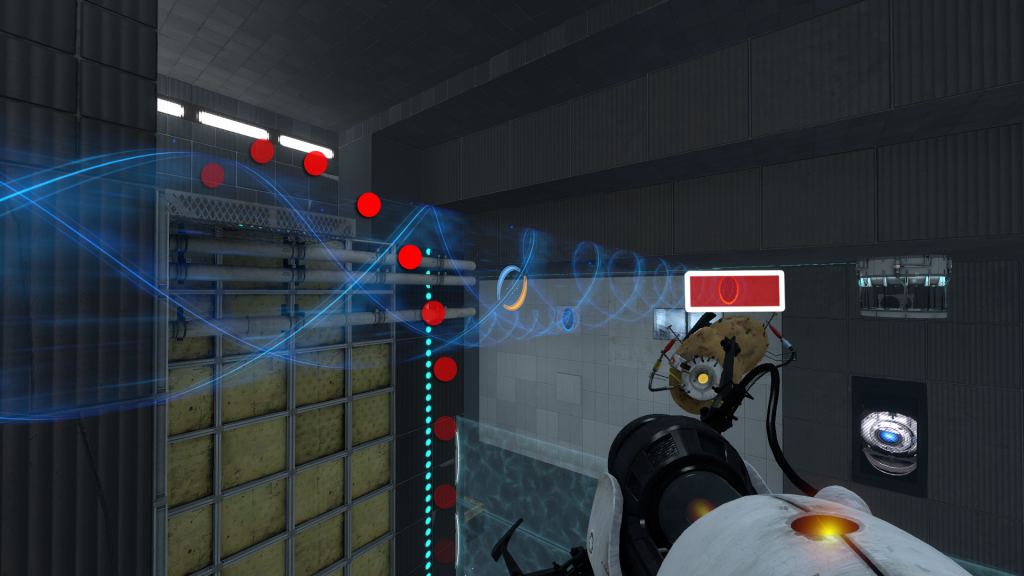
The portal shown on the picture allows the player to take the path in red and bypassing the flip panels. It is fixed by removing the marked surfaces that, aside from enabling interesting gameplay solutions, have no function to the puzzle.
Luckily, it is fixed easily with the removal of some portalable surfaces that are not of great relevance to the puzzle in general. The surfaces removed would add more opportunities to the player to solve the puzzles creatively, but there are still plenty of ways to solve the puzzle differently without them. Removing them is definitely a change I will make in order to make the chamber keep its length.
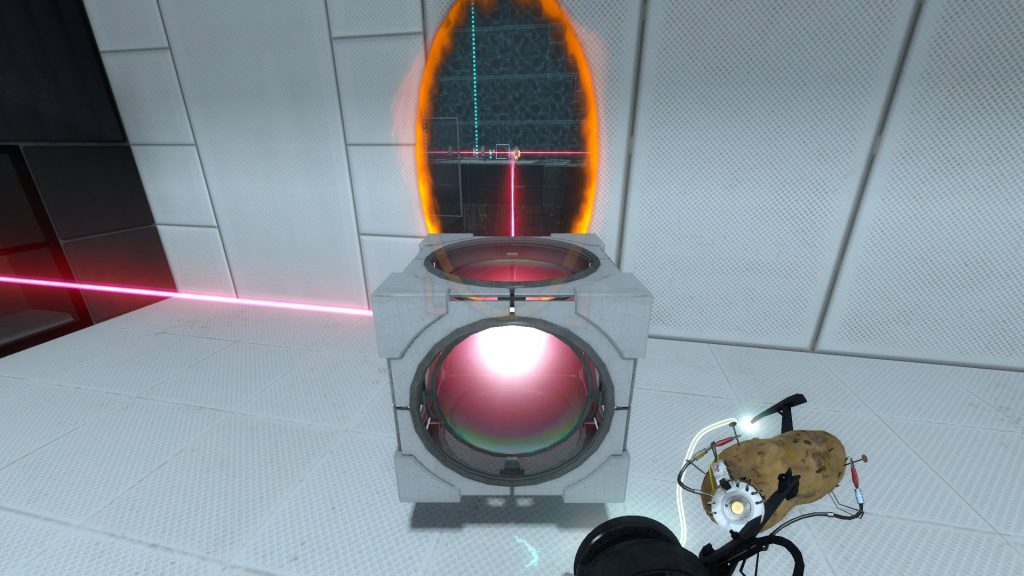
One of my favourite tricks to the map is to kill the turrets through sneaky Portals. 🙂
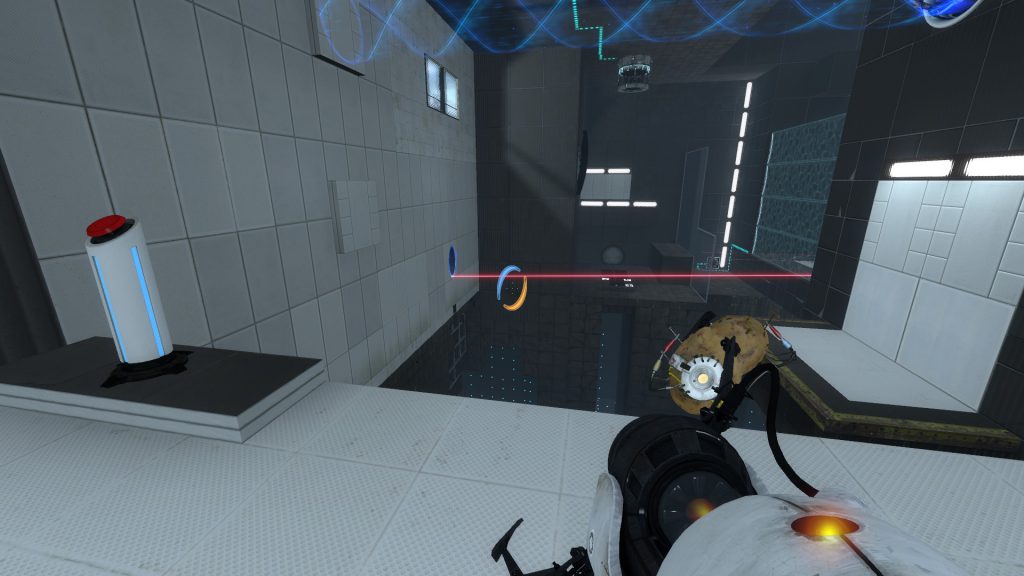
I even added a lighter texture to a portal surface suited for the trick, to very subtly bring the player's attention to the area. The lighter texture is also in more areas to provide variation and avoid repetition.
Closing thoughts
I really enjoyed working on this piece since I had such a clear goal in mind at all times. Even though my timeframe was too short to make a level that would fit into the original Portal 2, I feel proud of how close I got and what I accomplished. The project left me with many great ideas and some conclusions as to what makes a Portal map cool and fun, and I'm looking forward to create a longer and more intricate level over a longer stretch of time in the future.
If given a little more time to work on this project, there are my prioritised areas of polish:
- Customise the beginning and end sections (elevator corridors). This is to make them more interesting and to give the player a good first and last impression of the map.
- Open up the player's view of the funnel from the end platform (see picture above).
- Add lighting and props to the area behind the fizzler in order to make the flow of the level more clear (see picture above).
- Add voice-lines for GLaDOS and Wheatley, making him comment on the player's progression of the map for more immersion.
- Change the music to music from Chapter 8.
- Further polishing the environment to make it aesthetically as close to the original game as possible. While my preproduction helped me out a lot, I missed some of the finer points of the aesthetics in chapter 8 or ended up diverting from it by mistake, which I'd like to fix.
For my next Portal map I will make sure to spend as long as possible in the PTI editor and get as many as possible to playtest my prototypes. That part of the production of this map was the part in my process where my map evolved the most.
I hope you had fun reading about my level, please feel free to playtest it and give me some feedback! 🙂


